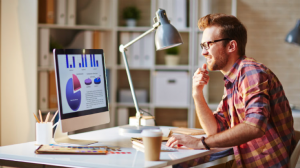To know what a REST API is, it is important to first know what an API (Application Programming Interface) is, and the benefits of an API for your business.
What is a REST API?
An API is a set of rules, protocols and specifications that allow different applications to communicate with each other, share data and information securely and easily.
Thus, a REST API works as a communication interface for web applications to communicate with each other in a simple and efficient way using the hypertext transfer protocol or HTTP.
There is currently no project or application that does not have a REST API for the creation of professional services based on this software. Twitter, YouTube, identification systems with Facebook… hundreds of companies that generate business thanks to REST and REST APIs. Without them, all horizontal growth would be virtually impossible. This is because REST is the most logical, efficient and usual standard in the creation of APIs for Internet services.
So, what is REST or RESTFul?
To give a simple definition, REST is any interface between systems that use HTTP to obtain data and generate operations on those data in all possible formats, such as XML and JSON. This is an increasingly popular alternative to other standard data exchange protocols such as SOAP (Simple Object Access Protocol), which have high capacity but are also very complex. Sometimes a simpler data manipulation solution such as REST is preferable. This is essential to work in digital ecosystems and integrate financial services.
REST completely changed software engineering from the year 2000. This new approach to developing web projects and services was defined by Roy Fielding, father of the HTTP specification and one of the leading international authorities on everything to do with Network Architecture, in his dissertation entitled “Architectural Styles and the Design of Network-based Software Architectures.” In the field of APIs, REST (Representational State Transfer) is today the “be all and end all” in service app development.
Features for an API to be considered REST
For an API to be considered REST, it must comply with a series of essential characteristics that facilitate interaction between systems on the web. Not only do these principles promote scalability and flexibility, but they also ensure that the API is easy to use and maintain.
Here are its key principles, also known as architectural constraints:
- Stateless client/server communication: Each HTTP request contains all the information necessary to execute it, which means that neither the client nor the server needs to remember any previous state to fulfill it. Be that as it may, some HTTP applications incorporate a cache memory. What is known as a stateless client-cache-server protocol is configured: It is possible to define some responses to specific HTTP requests as cacheable, so that the client can execute the same response for identical requests in the future. In any case, the fact that there is a possibility does not mean that it is the most recommended.
- Client-server architecture: This implies a total separation between the client and the server. The only information that the client application needs to know is the URI of the requested resource, without interacting with that of the server. Similarly, a server application should not modify the client application other than by passing it the requested data via HTTP.
- Uniform interface: To transfer data, the REST system applies specific actions (POST, GET, PUT and DELETE) on the resources, provided they are identified with a URI. This makes it easier to obtain a uniform interface that systematizes the process with the information.
- Layering System: hierarchical architecture between components. Each layer has a functionality within the REST system.
- Ability to send codes: In a REST API, the server can send executable code (such as Java applets or JavaScript) to the client when explicitly requested. This allows the client to expand its functionalities and gives it greater flexibility and extensibility in its operations.
All REST APIs must have the HATEOAS (Hypermedia As The Engine Of Application State) principle to be genuine. This principle ensures that each time a request is made to the server, and it returns a response, part of the information it contains will be the browsing hyperlinks associated with other client resources.
The advantages of REST for development
Separation between the client and server
The protocol of a REST API separates the user interface from the server and the data storage. This has some advantages when making developments. For example, it improves the portability of the interface to other types of platforms, it increases the scalability of the projects, and allows the different components of the developments to be evolved independently.
Visibility, reliability, and scalability
The separation between client and server is an obvious advantage of REST for APIs, and any development team can scale the product without too much trouble. They can migrate to other servers or make all kinds of changes in the database, provided the data from each request is sent correctly. The separation makes it easier to have the front and the back on different servers, and this makes the apps more flexible when working. If you are interested in testing and implementing our APIs, we have detailed guides for API developers.
Regardless of the type of platforms or languages
A REST API always adapts to the type of syntax or platforms you are working with, which offers great freedom when changing or testing new environments within development. With a REST API you can have PHP, Java, Python or Node.js servers. The only thing is that it is indispensable that the responses to the requests should always take place in the language used for the information exchange, normally XML or JSON.
REST API Examples
Google Translate and DeepL
Google Translate is one of the most widely used translation apps in the world. DeepL, although less known, has a higher quality. The good news is that both have REST APIs to be able to embed them within a website, an app or a service. This is key in companies with customers in countries with another language.
Wikipedia
Wikipedia’s REST API is a valuable tool for companies of a certain size, as it can automate the delivery of page updates, among other uses. This is useful for understanding a brand’s impact and proactively correcting mistakes. That is why it is one of the most prominent examples of REST API.
Why choose BBVA API Market APIs?
BBVA API Market is a solid option for any company that wants to take full advantage of technology. The platform offers a wide range of APIs selected to meet the different needs of companies in various areas such as cash flow management, funding or logistics, among others. It has detailed documentation, practical examples, and guides to help you with development and integration.
In addition, API Market’s infrastructure is designed to ensure security and performance, allowing companies to integrate these solutions with confidence. The benefits of the BBVA API Market for businesses include improving operational efficiency, developing new functionality and delivering better customer experiences.
If you want to discover the options they offer, you can visit our library of APIs for your business.


























